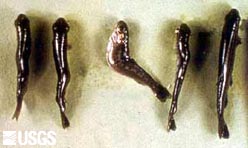- Home
- About S&T
- Taxa/Organisms
- Ecosystems
- Issues
- Methods & Tools
- Reports & Publications
- Location
- Search
2008 | Publisher: Other (RSC Publishing, Journal of Environmental Monitoring) | Format: URL
www.rsc.org — Environmental contaminant and biomarker monitoring data from major U.S. river basins were summarized for black bass (Micropterus spp.) and common carp (Cyprinus carpio) sampled over a nine year period. Cumulative frequency distributions revealed taxon differences for many organochlorine residue concentrations, elemental contaminant concentrations, More...

Publisher: Other (ScienceDirect (Elsevier)) | Format: URL
tinyurl.com — Organochlorine pesticide and total polychlorinated biphenyl (PCB) concentrations were measured in largemouth bass from the Tombigbee River near a former DDT manufacturing facility at McIntosh, Alabama. Concentrations of DDT isomers in McIntosh bass remained unchanged from 1974 to 2004 and were four times greater than contemporary concentrations More...

Publisher: USGS | Science Center: Western Fisheries Research Center (WFRC, Seattle) | Format: URL
wfrc.usgs.gov — This project addresses the occurrence of metal and organochlorine contaminant residues in commercial feeds purchased by the U.S. Fish and Wildlife Service (FWS) hatcheries. Research into fish feed quality could benefit all hatchery and aquaculture operations and assist in the interpretation of the effects of pollution on wild fish. Results from More...

Publisher: Other (Springer (Netherlands)) | Format: URL
tinyurl.com — Organochlorine chemical residues and elemental concentrations were measured in piscivorous and benthivorous fish at 111 sites from large U.S. river basins. Potential contaminant sources such as urban and agricultural runoff, industrial discharges, mine drainage, and irrigation varied among the sampling sites. Our objectives were to provide summary More...

Publisher: USGS | Science Center: Western Fisheries Research Center (WFRC, Seattle) | Format: URL
wfrc.usgs.gov — Bacterial kidney disease (BKD) is caused by Renibacterium salmoninarum and is considered to be the most difficult salmonid bacterial disease to control, in part because of its dual modes of transmission. This bacterium, unlike most other fish pathogens, is transmitted vertically from parent fish to progeny in association with the eggs, as well as More...

Publisher: USGS | Science Center: Western Fisheries Research Center (WFRC, Seattle) | Format: URL
wfrc.usgs.gov — Aquatic environments have been highly altered in California's Central Valley due to changes in hydrology caused by human development. The purpose of this study is to better understand the extent to which the Grassland Bypass Project (GBP) in the Central Valley of California has altered environmental conditions for fishes in Salt and Mud sloughs More...

Publisher: USGS | Science Center: Leetown Science Center (LSC, Kearneysville) | Format: URL
www.lsc.usgs.gov — During the summer and fall of 1996 and 1997, an unusually high prevalence of skin lesions in fishes from the Pocomoke River, Maryland and other tributaries of Chesapeake Bay stimulated significant public concern and scientific interest. This study examined the effect of environmental factors on weakening fish disease resistance of fish to the More...
